John Cullen 1838 - 1914
Clergyman poet - Curate St Mary the Virgin, Bottesford 1869 - 1874
John Cullen, clergymen and poet, is buried with his wife and infant son in Bottesford Churchyard. He was born and educated in Ireland. From 1867 – 1869 he was curate at Knipton, where he married a German woman, Leontine Dordinger. In 1869, he became Canon Norman’s curate at Bottesford and published Horae Poeticae, a collection of poems he had written in his youth. The 1871 census records John Cullen as living with his wife and 8 month-old daughter, Evelyn, in Chapel Street, presumably at the Glebe House, or Manse. They employed one servant, Eliza Challands, from Muston. The Cullens had three children, but one, Frederick Adelph, died in 1872, when only six months old. He was buried in Bottesford. This is presumably why Leontine Cullen, who died in 1906, and later John Cullen himself, were buried here.
In 1874 John Cullen became Vicar of Radcliffe on Trent, where he remained until his death in 1914. He continued to write poetry, but locally was more famous for his forthright personality and energetic evangelism. He established several missions in the area, rebuilt and enlarged St Mary’s, Radcliffe and campaigned for better public health after the deaths of a large number of children from scarlet fever, unintentionally making the village the focus of negative publicity. His parishioners remember his white beard, flat, clerical hat and the wicker-sided trap he drove. He was generally regarded as a benevolent, patriarchal figure.
Apart from Hymns and Sacred Songs, Cullen wrote poetry in a range of forms. The blank verse debate/drama, Ian and Edric is set variously on the seashore, in a Swiss Valley, in a large saloon, on the banks of the Trent, in Hades and in Paradise:
Scene – A Country Near a Forest – Ian and Edric witness a storm
Ian The low wind wails with moaning, piteous sound,
The thunder mutters, lightenings flash in rage.
The influence of Wordsworth is clear in the rustic narrative The Harvest Bride, or An English Idyll
It had been hot and sultry all the day
But now the heat was less; a pleasant warmth
Filled all the air, and a refreshing breeze
Was rushing through the woodland yellow leaved …
Home from their work in yonder harvest-field
Walked Farmer Dyson and his only son …
He also wrote a mini-epic in cantos:
The Captivity
The Gentile legions lusty shout
Was heard afar and near
And Famine, with her wolfish eye,
Saw men in trembling groups go by,
And heard the hungry mothers’ cry,
Whom their own children fear
and an historical Lay, reminiscent of MacCaulay:
The Lay of Forty Roman Martyrs
Cold winter blows the North wind across a frozen lake,
Where forty naked warriors brave are bound to a cruel stake
No food, no clothes are left them, the snow is falling fast,
Their naked bodies quiver, they feel the biting blast.
and lyrics, for example:
A Madrigal
Winter
Slowly and wearily
Breaks the grey morn
Silently, drearily,
Cold and forlorn
His poetry is perhaps most interesting for the light it throws on the thinking of a Tory clergyman struggling with current political changes:
Railway Man. Hold there I say!
The rights of man I preach, a radical
Am I. No narrow Tory here shall speak.
The Railway line has put its brake on Squire,
Conservative, and Tory-Parson too,
They rule no more! We are the people now…
Ian There is an honest discontent which men
Have with their lot. It urges them to seek
By earnest work, and honest rivalry,
To better their condition. And there is
Dishonest discontent, which idlers feel,
Communists men call these … [from Ian and Edric]
All Cullen’s verse is imbued with deep religious feeling. None is in print today. Poems and Idylls was published in 1882 and 1893, with a collected edition in 1904 which went into several editions. He describes his aims in the foreword as: ‘to point out the beautiful in nature … to cheer desponding hearts by singing of our Father in heaven … to teach to all the beauty of love … and to find good in everything.’
Cullen achieved a degree of national and international recognition when his poem Queens Regnant, written for recitation at Baltimore Female College in the United States, was published. Queen Victoria thanked him for his work and in America he was hailed as champion of women’s rights and congratulated on his ‘conceptionof the power and high calling of Christian womanhood‘. In his notes on A Vision of Good Women he wrote:
He is still considered to be a figure of sufficient importance to merit an entry in The Dictionary of National Biography.
Cullen’s poem of farewell to his sisters when they emigrated to Austalia in 1858.
http://openlibrary.org/books/OL6590334M/Poems_and_idylls.
Sources
- Poems and Idylls by John Cullen London, Elliot and Stock 1904
- P. Priestland, ed. Radcliffe-on-Trent, 1837 to 1920: a study of a village during an era of change (1989) Ashbracken, Radcliffe-on-Trent, Nottingham.Pamela Priestland
- Cullen, John (c.1838 – 1914), Oxford Dictionary of National Biography, Oxford University Press 2004 [http://oxforddnb.com]

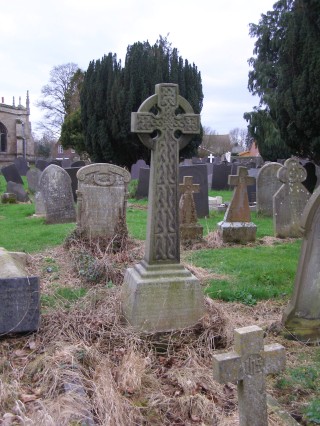
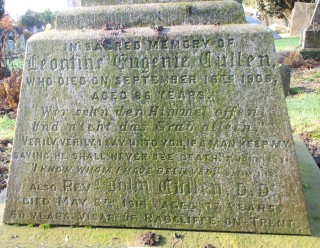
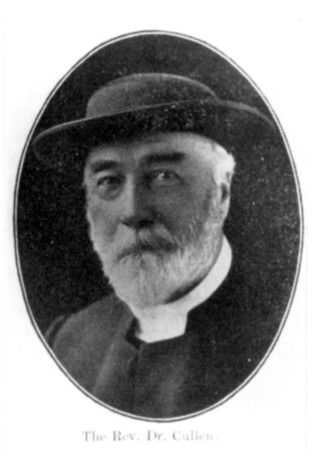
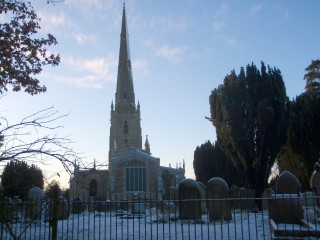
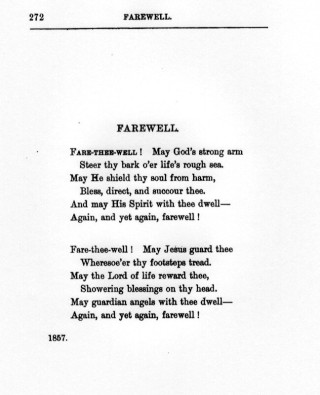
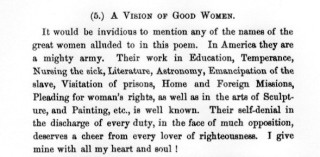
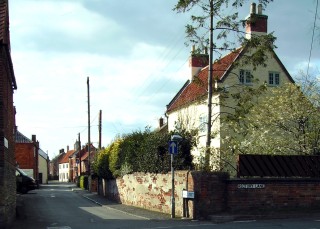








Comments about this page
A descendant of the Cullen family has recently contacted us with additional information. John Cullen “was the brother of my great-great-grandmother Anne Cullen, who with her first two children and her sister Johanna migrated to Australia in 1858” …John Cullen’s book ‘Poems and Idylls’ can be read in its entirety on the Internet (http://openlibrary.org/books/OL6590334M/Poems_and_idylls). He wrote two brief poems of farewell to his sisters, which (slightly modified) appear in the book as a poen called ‘Farewell’… (see above). The inscription on the book shows that it is a gift from the author to Professor H.W. Longfellow, presumably the noted American poet, Henry Wadsworth Longfellow.”
The 1881 census for Radcliffe on Trent shows that he and Leontine had two other children (apart from Frederick Adolph), a daughter Evelyn and a son Cecil Donald Cullen, who, like his father, became a clergyman. Cecil Donald served in some quite exotic locations [notably Libau and Archangel, Russia, in the years before W.W.1].
‘Poems and Idylls’ includes poems which John wrote for his wife and his mother, as well as for Evelyn and Cecil. The poem about Cecil is particularly sweet, written at Christmas time in 1876.
John Cullen also compiled a book called The Hundred Best Hymns in the English Languge, published circa 1908. It includes two hymns written by him and one by Cecil Donald.”
The census also shows that their household at Radcliffe included a Governess, a housemaid and a cook, Sarah Topps of Muston, age 17.
As one of the current churchwardens at St. Mary’s Radcliffe on Trent I was interested in this history of John Cullen. We have a stained glass window in the tower room at St. Mary’s to John Cullen’s memory as well as a small plaque to the memory of his son Frederick Adolph. Their wedding certificate shows them as married at Knipton Church in the Vale of Belvoir and Leontine Eugenie Derndinger’s father as a Barrister in Law from Heidelberg, Germany.
Dear Martin, Thank you for your comments and information about the memorials to John Cullen at Radcliffe. We will make a point of calling to examine the window and plaque, and take photographs to add to this webpage.
Add a comment about this page